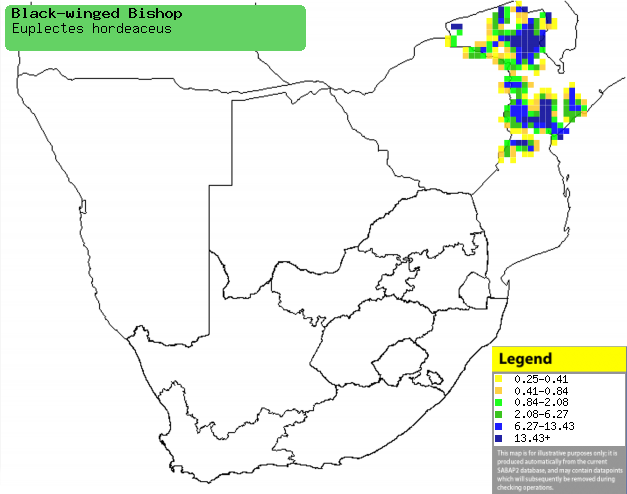|
Euplectes hordeaceus
(Black-winged bishop, Fire-crowned bishop)
Vuurkopvink [Afrikaans];
Roodvoorhoofdwever [Dutch]; Euplecte monseigneur [French]; Feuerweber,
Flammenweber [German]; Cardeal-tecel„o-de-coroa-vermelha [Portuguese]
Life
> Eukaryotes >
Opisthokonta
> Metazoa (animals) >
Bilateria >
Deuterostomia > Chordata >
Craniata > Vertebrata (vertebrates) > Gnathostomata (jawed
vertebrates) > Teleostomi (teleost fish) > Osteichthyes (bony fish) > Class:
Sarcopterygii (lobe-finned
fish) > Stegocephalia (terrestrial
vertebrates) > Tetrapoda
(four-legged vertebrates) > Reptiliomorpha > Amniota >
Reptilia (reptiles) >
Romeriida > Diapsida > Archosauromorpha > Archosauria >
Dinosauria
(dinosaurs) > Saurischia > Theropoda (bipedal predatory dinosaurs) >
Coelurosauria > Maniraptora > Aves
(birds) >
Order: Passeriformes > Family: Ploceidae
> Genus: Euplectes
Distribution and habitat
Occurs across much of sub-Saharan Africa, from Senegal to
Ethiopia south through the DRC, Tanzania, Zambia and Angola to southern Africa.
Here it is uncommon to locally common in north-central Mozambique and adjacent
Zimbabwe, generally preferring moist areas within miombo (Brachystegia)
woodland, grassland with scattered bushes and cultivated land, especially rice
paddies.
|
 |
|
Distribution of Black-winged bishop in southern Africa,
based on statistical smoothing of the records from first SA Bird Atlas
Project (©
Animal Demography unit, University of
Cape Town; smoothing by Birgit Erni and Francesca Little). Colours range
from dark blue (most common) through to yellow (least common). |
Food
It mainly eats grass seeds taken from the ground, although
it may occasionally hawk insects from a low perch. The following food items have been recorded
in its diet:
- Grass seeds
- Panicum maximum (Guinea grass)
- Hyparrhenia
- Pennisetum
- Rottboellia
- rice
- green maize
- Insects
Breeding
- Polygynous and territorial, meaning that each male usually mates with
multiple females in one breeding season, usually nesting solitarily but
sometimes joining other males to form a loose colony.
- The male often builds 2-4 nests in a breeding season, which consist of
an oval-shaped structure made of woven grass with a large side-top entrance
concealed by a hood of grass inflorescences; once the female approves it she
adds a lining of fine grass. It is typically placed between upright or grass
stems or in coarse vegetation, usually over dry ground.
- Egg-laying season is from January-April, peaking from February-March.
- It lays 2-4 eggs, which are incubated solely by the female for about
12-13 days (recorded in captivity).
- The chicks are fed by the female only, leaving the nest after about
11-13 days.
Threats
Not threatened, in fact it seems to have benefited from
agriculture.
References
-
Hockey PAR, Dean WRJ and Ryan PG 2005. Roberts
- Birds of southern Africa, VIIth ed. The Trustees of the John Voelcker
Bird Book Fund, Cape Town.
|
